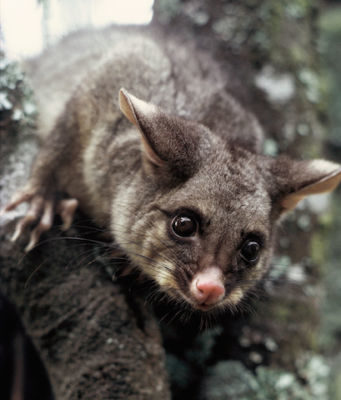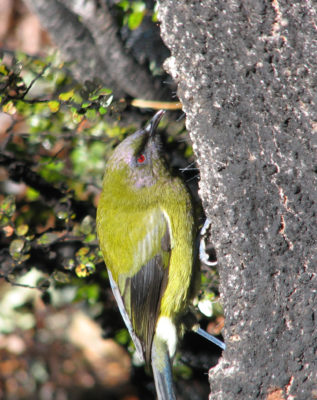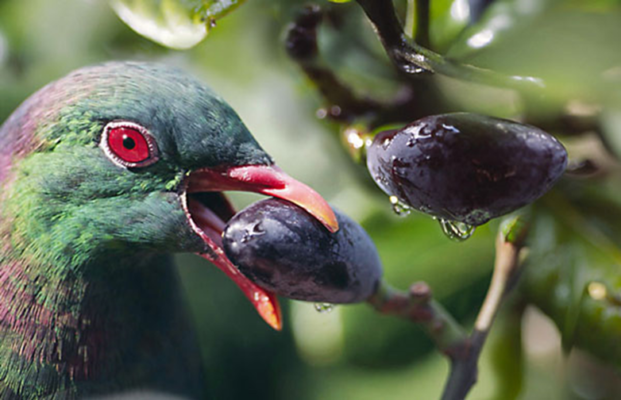When possums live in an urban landscape, their fondness for fruit, flowers and foliage quickly makes then unpopular with gardeners. They can be noisy on the roof at night too. But the impact they’re having on local birdlife may not be quite so obvious.

Well fed on apples and roses, urban possums may or may not be seeking out birds’ eggs or killing nestlings. But even those on a vegetarian diet are still doing birds harm – as was shown when possums were targeted for pest control in the suburb of Napier Hill.
The possum control operation and associated research project were carried out jointly by Hawke’s Bay Regional Council and Landcare Research over the period from 2009 – 2014. From 2011 on, Napier Hill residents took responsibility for refilling bait stations on their own properties with costs subsidised by HBRC, while the Council itself continued to service bait stations on public land.
“The Napier Hill Possum Control Area is a 282 ha mixture of residential properties and public land in Napier, Hawke’s Bay, with over 2,700 residents. Napier Hill is heavily vegetated, primarily by introduced trees and scrub, and with some native plant species still present. Despite suspected high densities of invasive possums and rats, native bird species such as bellbird, tui and kereru persisted in the area before pest control commenced.”
When the project began, residents were given a choice of the control method used on their properties. Most opted for bait stations, but some Timms traps were also used.
“Kilmore® and Sentry® bait stations were erected by a pest control contractor on trees 1-2 m above ground and baited with Pestoff® brodifacoum (0.02g/kg) pellets with a layer of RatAbate® diphacinone (0.05g/kg) paste on top to kill rats and stop them from clearing bait stations before possums could feed from them. Although rats were poisoned, their numbers were probably not reduced significantly because the distance between bait stations was large relative to rat home range size. In total 480 bait stations were set up across public land and 363 residential properties, at a distance of 100-200 m apart.”
Five-minute bird counts were used to monitor the abundance of birds. Changes in abundance locally were also compared with national figures for bird population fluctuations so that national trends could be taken into account when assessing the impact of the control operation.
Some native bird species appeared to benefit more from the removal of possums than others. Bellbird numbers were quick to show an increase.

“There was a highly significant increase in the number of bellbirds recorded between January 2009 and December 2014. The mean number of individuals recorded at each count site doubled from 0.33 in January 2009 to 0.67 in January 2010, after just one year of possum control. The population remained stable from January 2011 to December 2011 before increasing between December 2011 and December 2014.”
Tui responded more slowly, but also showed an increase.
“Although more gradual, the number of tui recorded increased steadily and significantly over the six year monitoring period. National population trends for both tui and bellbird were were stable during this time. Fantails also increased in relative abundance between January 2009 and December 2014 whereas no significant change in fantail numbers was recorded nationally. No significant changes were found in the relative abundance of kereru and grey warbler either in our study or nationally.”
Although possums were being controlled, rats and other predators (including pet cats) were still present in the Napier Hill suburb. The increase in birdlife wasn’t so much about the removal of predators as the removal of competitors. Nectar and fruit make up a large proportion of the diet of both tui and bellbirds.
“Possums feed on the buds, flowers and fruits of plants and can suppress fruiting in some native plant species. After the eradication of possums on Rangitoto, an island in the Hauraki Gulf by Auckland, North Island, the number of tui increased. This was attributed to increased nectar availability, as predators (ship rats, cats and stoats) were still present. For this reason it is concluded that the rapid increase in bellbirds and the more gradual increase in tui recorded at Napier Hill were likely to be due to an increase in food availability attracting more individuals to the area.”

Kereru are also big eaters of fruit and leaves, yet kereru numbers remained stable in the Napier Hill suburb. So why didn’t they respond to reduced competition from possums in the same way as tui and bellbirds?
“There are several possible explanations for the lack of increase in kereru following possum control. Many studies have documented rats predating on both the eggs and newly hatched chicks. Kereru may be more susceptible to rat predation than tui and bellbirds and without targeted rat control on Napier Hill increases may not be seen. Another possibility is that the number of individuals recorded was too low to detect a change over time. Alternatively, Napier Hill may not provide sufficient habitat to support an increase in kereru numbers.”
There was, however, some good news about kereru during the study period.
“In November 2009 a resident found a kereru fledgling, presumably having been tipped out of a tree during high winds; this was the first evidence of kereru breeding in the area in 30 years… The discovery of a fledgling was encouraging as it showed kereru were breeding in the area. We hypothesize that kereru may respond more gradually and that continued control of possums could allow for a stable breeding population to establish in the area.”
The study also had a positive impact on the Napier Hill community.
“Feedback from residents of the area has been extremely positive. Many report seeing and hearing more native birds and note an increase in fruit and flowers in their gardens. This study would have benefitted considerably from rigorous monitoring of fruit and flowers and it is suggested here that this be included in future possum control studies. Hawke’s Bay Regional Council has received many positive comments from residents and the local press. Residents have also become actively involved in the programme by refilling baiting stations themselves, the cost of which is subsidised by the council. This is vital in the continuation of the programme.”
The full research paper is published in Conservation Evidence and freely available online.
Possum control and bird recovery in an urban landscape, New Zealand (2015)

